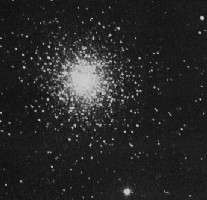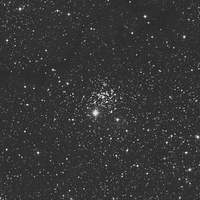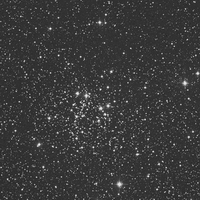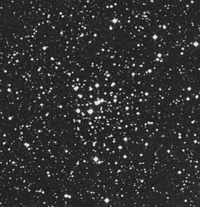



| Observer: | Tom Campbell |
| Location: | Iola, Kansas (Long: 95°24'W Lat: 37°55'N) |
| Equipment: | 8" Discovery DHQ dob |
| Eyepieces: | 1.25" Plössls - 25mm (49x), 15mm (81x), 10mm (122x), 6.5mm (188x), 4mm (305x) |
| Filters: | O-III |
| Time: | 9:00pm - 11:30pm CDT (02:00-04:30 UT) |
| Transparency: | Clear (8/10) |
| Seeing: | Stable (9/10) |
| Weather: | Temperatures in the lower 90s. There was little to no wind. |

Friday night was beautiful, but I didn't get home until after 10:00pm, and didn't feel like setting up. By the time I set up my equipment and waited for the telescope to cool down, it would be about time for me to call it quits for the evening. When Saturday evening brought cumulous clouds, I was really beginning to regret my decision to have wasted a chance to observe during the new moon weekend.
Sunday night was my last chance. Although the evening sky was partly cloudy, most of the clouds were concentrated in sections of the sky that were blocked from my view anyway. I decided to chance it and set up.
As it turned out, my decision was a good one. As the night wore on, the clouds moved out, and clear air settled in. I didn't really have an observing plan tonight, but I did have a list of Herschel objects handy, which I've been working on for the last several months.
After the first few observations, I started to notice a pattern develop in that the objects I viewed could be described with words beginning with a letter D. After that, I started picking out objects at random from my list, and seeing if I could continue the pattern.
"D" IS FOR DONUT | |||
| NGC 6811 | Cygnus | Open Cluster | 9:05pm CDT |
| Mel 222 | RA: 1937.2 | Dec: +4622 | Mag: 6.8 |
 |
This cluster is right off of Delta Cygni. It is fairly large, but the stars are a bit faint. A large number of brighter stars surround the cluster. At 81x, the cluster will still fit in the field of view, but will block out most of the bright non-cluster stasr, making it easier to concentrate. The shape is irregular, roughly oval. It is a bit sparse, consisting of strings and arcs of stars, rather than clumps or knots. The center of the cluster is mostly devoid of stars, giving it a somewhat donut-like appearance. With averted vision, more stars become visible, a couple dozen in all. It's not a bad-looking cluster, but it also isn't very spectacular. |
||
"D" IS FOR DRAGON'S EGG | |||
| NGC 6543 | Draco | Planetary Nebula | 9:15pm CDT |
| Cat's Eye Nebula | RA: 1758.6 | Dec: +6638 | Mag: 8.8 |
 |
With the body of Draco wrapped around this little gem, it is more like an egg than an eye. The highest power my eyepieces will allow is 305x, but I wish I could bump it up more tonight. The seeing was steady enough to provide pretty steady views even at this magnification. The nebula is oval, with a hint of mottling throughout. A nearby field star makes it easy to obtain a sharp focus on the nebula. It appears blue, with just a touch of green. |
||
"D" IS FOR DOUBLE DIAMOND | |||
| NGC 6830 | Vulpecula | Open Cluster | 9:30pm CDT |
| Mel 224 | RA: 1951.0 | Dec: +2303 | Mag: 7.9 |
 |
The best view of this cluster is at 125x. The main part of the cluster is a little diamond pattern of four fairly bright stars. A larger diamond pattern surrounds this, with the same orientation. The outer diamond has a few additional stars along one edge. It is more impressive at low powers because it looks like an interesting knot. |
||
"D" IS FOR DUMBBELL | |||
| M 27 (Dumbbell Nebula) | Vulpecula | Planetary Nebula | 9:40pm CDT |
| NGC 6853 | RA: 1959.6 | Dec: +2243 | Mag: 7.6 |
 |
While in the area of Vulpecula, I couldn't resist the opportunity to take another peek at M27. I'm glad I didn't. Unfiltered at 125x, it shows some traces of the fainter outer shell surrounding the familiar dumbbell (or apple core) shape. At 125x with the O-III filter in place, it looks fantastic. The bright apple core center is easily visible, but the overall shape of the nebula is oval, with the core area making it look almost like the eye of a cat. A little bit of mottling could also be detected with averted vision. At low power, it is still impressive, with a lot of bright Milky Way stars surrounding it. |
||
"D" IS FOR DENSE | |||
| M 15 | Pegasus | Globular Cluster | 10:05pm CDT |
| NGC 7078 | RA: 2130.0 | Dec: +1210 | Mag: 6.3 |
 |
By kicking up the magnification to 305x, hundreds of tightly-packed pinprick stars are visible. At low powers, the stars are too close together to be detected as anything but fuzz and nebulosity. The cluster appears to be not-quite circular. One side seems to have a wider dispersal of stars. On the other side, the stars seem to end abruptly, like a bowshock effect. I've never noticed this before about this globular. |
||
"D" IS FOR DOUBLE STAR | |||
| g Gamma | Andromeda | Double Star | 10:15pm CDT |
| Almaak | RA: 0203.9 | Dec: +4220 | Mag: 2.3 |
125x provides a drop-dead gorgeous view of this binary system. The primary is bright yellow, and the fainter companion is blue-white. This pair puts Albireo to shame, in my opinion. Although cleanly split at even 49x, the view at 125x provides just enough separation to make it look like you are at the edge of its solar system, looking inward. I felt like if I stared at it long enough, I would be able to actually see the stars orbiting each other. |
|||
"D" IS FOR DUNCE CAP | |||
| NGC 7686 | Andromeda | Open Cluster | 10:25pm CDT |
| CR 456 | RA: 2330.2 | Dec: +4907 | Mag: 5.6 |
 |
This is a loose and sparse open cluster. It seems to be shaped like a Christmas tree or Dunce cap. No more than a couple dozen stars are visible, scattered throughout. The brightest stars are along the outer edges of the cluster. Two real bright stars are along one edge. |
||
"D" IS FOR DOUBLE CLUSTER | |||
| Double Cluster | Perseus | Open Clusters | 10:30pm CDT |
| NGC 869/884 | RA: 0219.4 | Dec: +5708 | Mag: 5.3 |
 |
The Double Cluster was just coming up over the trees, so I had to take my first peek of the season. NGC884 is a bit larger and more spread out, and NGC869 has a couple of bright stars and a tight knot of stars right in the center. Each of the clusters is worthy in its own right, but when seen together. Since NGC869 was the more impressive of the two, I upped the magnification to 81x on it. The number of visible stars was increased, and the two bright stars began to appear as two glowing eyes of similar brightness. Over one of the eyes was a semicircle of four or so stars which looked like an eyebrow, and underneath the same eye were three small strings of stars, resembling tear streaks. A fainter star between the two eyes serves as a nose. |
||
"D" IS FOR DRAWSTRING | |||
| NGC 654 | Cassiopeia | Open Cluster | 10:45pm CDT |
| Mel 9 | RA: 0144.0 | Dec: +6153 | Mag: 6.5 |
 |
This cluster is small and tight, with a bright star at one edge. At 188x, it fits nicely into the field of view. It has an irregular shape. A straight-line chain of widely spaced stars could be a drawstring on the bag of stars, or it could make it look something like a capital R. The densest concentration of stars was within the bag (or hump of the R). With averted vision, about two dozen stars were visible, of similar magnitude. |
||
"D" IS FOR DIAMOND | |||
| NGC 663 | Cassiopeia | Open Cluster | 10:50pm CDT |
| Mel 11 | RA: 0146.3 | Dec: +6113 | Mag: 7.1 |
 |
This open cluster is a lot larger than NGC654, and has a roughly diamond shape. The brightest stars form an arcing line along the minor axis of the diamond. Most of the concentration of stars is along the edges of the diamond, sprinkled ireegularly. The best view is at 81x |
||
"D" IS FOR DODGE | |||
| NGC 659 | Cassiopeia | Open Cluster | 11:00pm CDT |
| Mel 10 | RA: 0144.4 | Dec: +6040 | Mag: 7.9 |
 |
This open cluster is pretty unimpressive. It is small and sparse, with only about a dozen stars visible. The stars are somewhat faint. Overall, the shape is that of a pentagon (similar to the Dodge emblem), with one of the points being a triple star in nearly a straight line. 188x offers the best view. |
||
"D" IS FOR DRAB | |||
| NGC 1027 | Cassiopeia | Open Cluster | 11:15pm CDT |
| Mel 16 | RA: 0242.6 | Dec: +6136 | Mag: 6.7 |
 |
This cluster is large and spread out, made of fairly bright stars. It has an irregular shape. At one edge is a bright star. It is somewhat difficult to tell exactly which stars belong to the cluster. The stars seem to be clusted in arcs and strings rather than clumps or knots. The best view is at 49x, although more stars are visible at 81x. |
||
"D" IS FOR DOUBLE-TAKE | |||
| NGC 7790/7788 | Cassiopeia | Open Clusters | 11:25pm CDT |
| CR 461 | RA: 2358.4 | Dec: +6112 | Mag: 8.5 |
 |
NGC-7790 is a large cluster, with the best view at 81x. The trapezoid-shaped cluster consists of bright stars sprinkled sparsely in groups of one or two. One corner of the trapezoid appears to be a wide double. Off on one edge of the cluster is a small knot of about a dozen stars in a kidney-bean shaped patch. This is NGC-7788. The star chart I had with me didn't show this cluster, so it was a nice surprise. |
||
Because of the partly cloudy start to the evening, I was somewhat hesitant to set up tonight. But I'm glad I did!